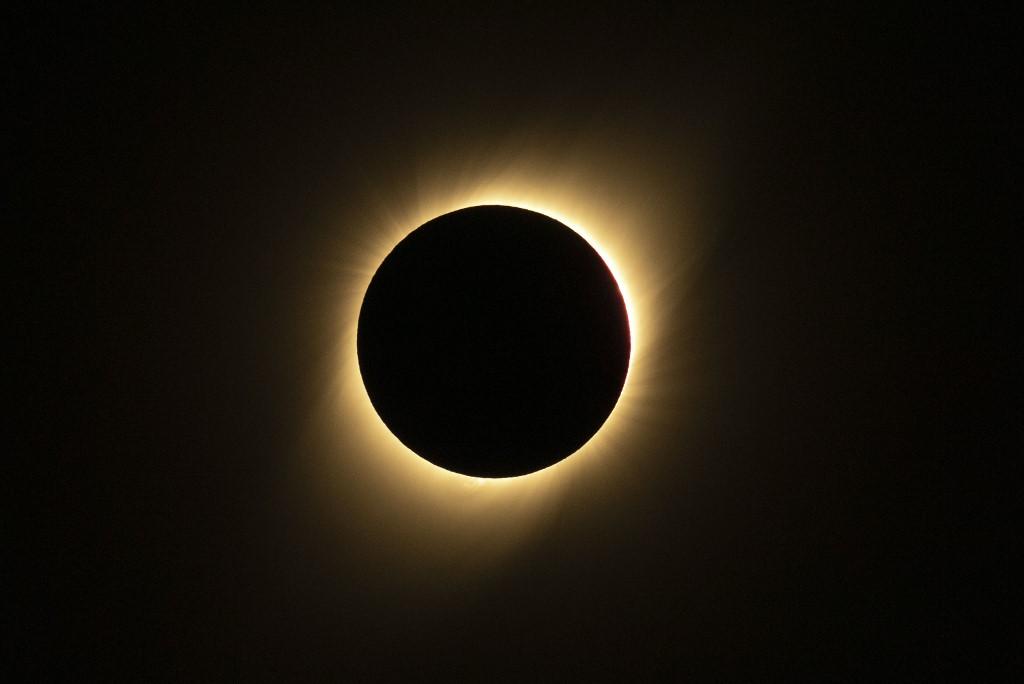
[ad_1]
Chileans will turn their eyes to the sky on Monday to admire a total solar eclipse, but unlike last year’s phenomenon, their numbers will be severely reduced by coronavirus restrictions.
Some 300,000 people flocked to the Atacama desert in northern Chile in July 2019, home to several observatories.
On Monday it will be the turn of the Araucanía region in the south that is home to the Mapuche indigenous community to observe the eclipse.
Their ability to do so will be severely hampered by the latest measures announced Thursday by the government, restricting the movement of people out of the Santiago metropolitan area after an increase in virus-positive cases.
To observe the phenomenon, when the moon passes between the Earth and the sun, completely blocking the latter, it is necessary to be in the exact area of 90 kilometers long that you will enjoy the full effect.
And they will only have two minutes, nine seconds around 1:00 pm (1600 GMT) to see the eclipse, framed by the backdrop of the Villarrica volcano, one of the most active in the country.
The eclipse will then cross the imposing Andes mountain range to be visible in Argentina as well, especially in the popular tourist destination of Bariloche.
Then it will disappear over the South Atlantic.
‘Two minute night’
“A two-minute night during which nature changes,” is how Chilean astronomer José Maza described the moment when the daytime sky turns purple before turning into darkness and revealing stars and planets like Jupiter, Saturn and Venus.
“At the time of the eclipse, the temperature drops around five degrees (Celsius) and the wind picks up, so if people are not indoors they will feel a little cold,” he added.
Every year there are two total eclipses of the sun but depending on the time of day or year they may not be visible.
While last year it took place at dusk, this time it will be in the middle of the day.
“At noon the phenomenon will be high in the sky and the eclipse will be much more visible,” Maza said.
After last year’s massive gathering in the Atacama Desert, the Araucanía region was expecting a tourism bonanza, but Covid put an end to that.
There have been more than 560,000 positive cases in Chile among the 18 million inhabitants, with almost 15,700 deaths.
Authorities are concerned that social gatherings during the Christmas season could lead to a series of new virus outbreaks.
Strict controls have been announced for the areas where the total eclipse will be seen, with free movement prohibited both the day before and after.
The battle of the sun
The event is anticipated by the Mapuche indigenous community, which is the largest in southern Chile.
They have a strong traditional relationship with nature and the cosmos and even believe that an eclipse, called “lan antu” in the Mapuzungun language, signals the “temporary death of the sun,” Juan Nanculef told AFP.
“They realized that after the sun went down there were social conflicts, scarcity, the land produced less, the crops were bad, the land weakened,” said Nanculef, an expert on Mapuche culture.
They believed that an evil force, the “Wekufu”, was attacking the sun and trying to extinguish it.
“They lit bonfires, burned natural trees like cinnamon, laurel and boldo to help the sun in its battle. They also threw stones and arrows into the air. When the sun came back they celebrated because the sun had won ”.
Eclipses are seen as generators of change by the Mapuche, whose territory before European colonization encompassed parts of southern Chile and Argentina.
“The primitive peoples worshiped the sun as a god, they already knew that everything we are we owe to the sun,” said Maza.
“Without the sun, everything dies on Earth, absolutely everything.” -French Media Agency